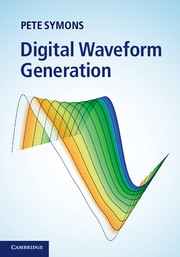Book contents
- Frontmatter
- Contents
- Preface
- Acknowledgements
- Glossary of terms
- 1 Introduction to waveform generation
- 2 The foundations of digital waveform generation
- 3 Recursive sine wave oscillators
- 4 DDS sine wave generation
- 5 DDS arbitrary waveform generation
- 6 Dynamic waveshape and spectrum control
- 7 Phase domain processing – DDS and the IDFT
- 8 Hardware implementation architectures
- 9 Digital to analogue conversion
- Index
- References
1 - Introduction to waveform generation
Published online by Cambridge University Press: 05 November 2013
- Frontmatter
- Contents
- Preface
- Acknowledgements
- Glossary of terms
- 1 Introduction to waveform generation
- 2 The foundations of digital waveform generation
- 3 Recursive sine wave oscillators
- 4 DDS sine wave generation
- 5 DDS arbitrary waveform generation
- 6 Dynamic waveshape and spectrum control
- 7 Phase domain processing – DDS and the IDFT
- 8 Hardware implementation architectures
- 9 Digital to analogue conversion
- Index
- References
Summary
Systematic generation of periodic signals with electronically controlled frequency, phase, amplitude and waveform shape (or waveshape) is ubiquitous in nearly every electronic system. The sinusoidal local oscillator in a super-heterodyne radio receiver is a simple example of a signal source whose controllable frequency tunes the receiver. Another example is a step input waveform (e.g. a square wave) that allows us to measure the step response of a closed-loop control system (e.g. rise time, fall time, overshoot and settling time) under controlled excitation conditions. A more complex ‘staircase’ input waveform allows us to measure step response at particular points over the system's dynamic range and is useful for investigating non-linear behaviour.
The progressive migration towards ‘software defined’ systems across all application domains is driving the development of high performance bespoke digital signal generation technology that is embeddable within a host system. This embedding can take the form of a software code or a ‘programmable logic’ (e.g. FPGA) implementation depending on speed, with both implementations satisfying the software definable criterion. Today, applications as diverse as instrumentation, communications, radar, electronic warfare, sonar and medical imaging systems require embedded, digitally controlled signal sources, often with challenging performance and control requirements. Furthermore, many of these applications now require signal sources that generate non-sinusoidal waveforms that are specified according to a precisely defined waveshape or spectrum function that is peculiar to the application. Moreover, in addition to conventional frequency, phase and amplitude control, these signal sources can have vastly increased utility by providing parametric and thereby dynamic control of waveshape or corresponding spectrum. As we will see, there are several digital waveform generation techniques that provide this functionality.
Information
- Type
- Chapter
- Information
- Digital Waveform Generation , pp. 1 - 48Publisher: Cambridge University PressPrint publication year: 2013
